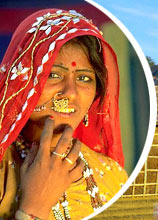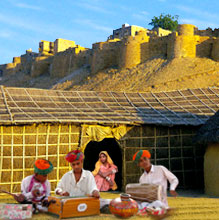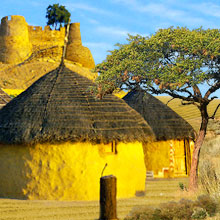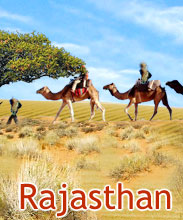 Rajasthan
tribals constitute around twelve percent of the total population of the
state. The tribes of Rajasthan, India constitutes of mainly Bhils and
the Minas. Infact, they were the original inhabitants of the area where
Rajasthan stands now. Apart from these main tribes, there are also a
number of smaller tribes in Rajasthan. However all Rajasthan tribes
share certain common traits, the variations being in their costumes,
jewelry, fair and festivals, etc
Rajasthan
tribals constitute around twelve percent of the total population of the
state. The tribes of Rajasthan, India constitutes of mainly Bhils and
the Minas. Infact, they were the original inhabitants of the area where
Rajasthan stands now. Apart from these main tribes, there are also a
number of smaller tribes in Rajasthan. However all Rajasthan tribes
share certain common traits, the variations being in their costumes,
jewelry, fair and festivals, etcHere are the main tribes and nomads of Rajasthan:
Bhils
Around 39% of Rajasthan tribals comprises of the Bhils. Dominating in the Banswara area of Rajasthan, the Bhils are believed to be fine archers. Infact, Bhil bowmen even found a reference in the great epics Mahabarata and Ramayan. The Bhils were originally food gatherers. However, with the passage of time, they have taken up small-scale agriculture, city residence and employment. The major festivals of Bhils are the Baneshwar fair (held near Dungarpur) and Holi.
Minas
The second largest tribal group of Rajasthan is that of the Minas. The original inhabitants of the Indus Valley civilization, Minas have a tall, athletic build with sharp features, large eyes, thick lips and a light brown complexion. They are found dominating the regions of Shekhawati and eastern Rajasthan. Minas solemnize marriage in the younger years of the children.
Gadiya Lohars
Gadiya Lohars are wandering blacksmiths that are named after their attractive bullock carts called gadis. Initially a martial Rajput tribe, they left their homeland when Emperor Akbar ousted Maharana Pratap from Chittorgarh.
Garasias
Garasias is a small Rajput tribe inhabiting Abu Road area of southern Rajasthan.
Sahariyas
Sahariyas, the jungle dwellers, is considered as the most backward tribe in Rajasthan. Believed to be of Bhil origin, they inhabit the areas of Kota, Dungarpur and Sawai Madhopur in the southeast of Rajasthan. Their main occupations include working as shifting cultivators, hunters and fishermen.
Damors
Belonging to the Dungarpur and Udaipur districts, Damors are mainly cultivators and manual laborers.
Rajasthan tribes include the following also:
- Meo and Banjara (the traveling tribes)
- Kathodi (found in Mewar region)
- Rabaris (cattle breeders, found in Marwar region)
- Sansi
- Kanjar










